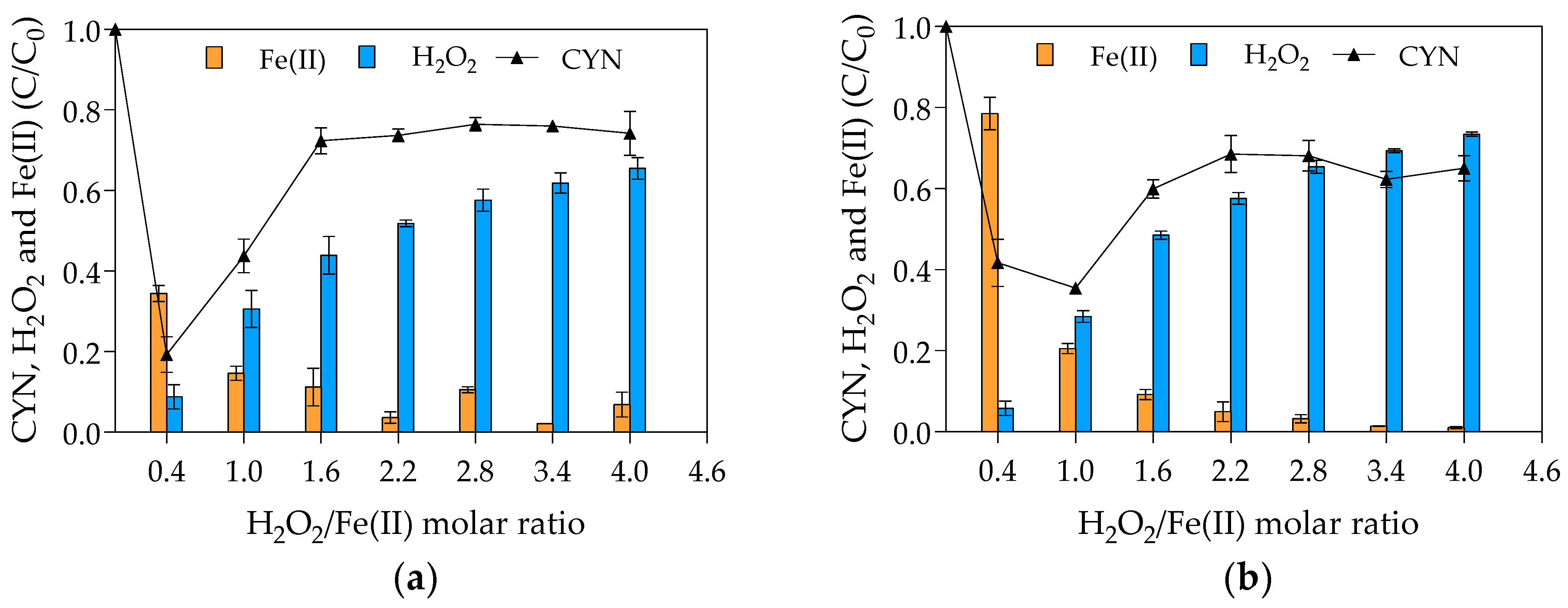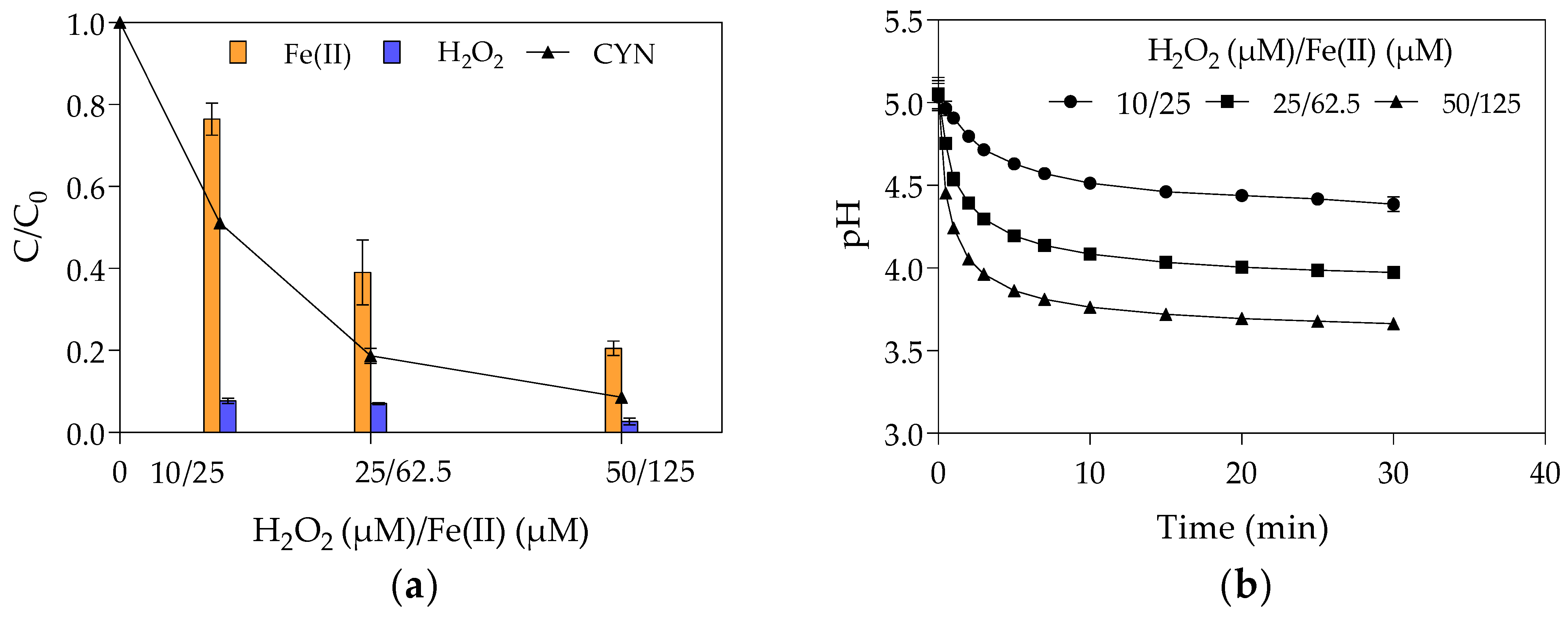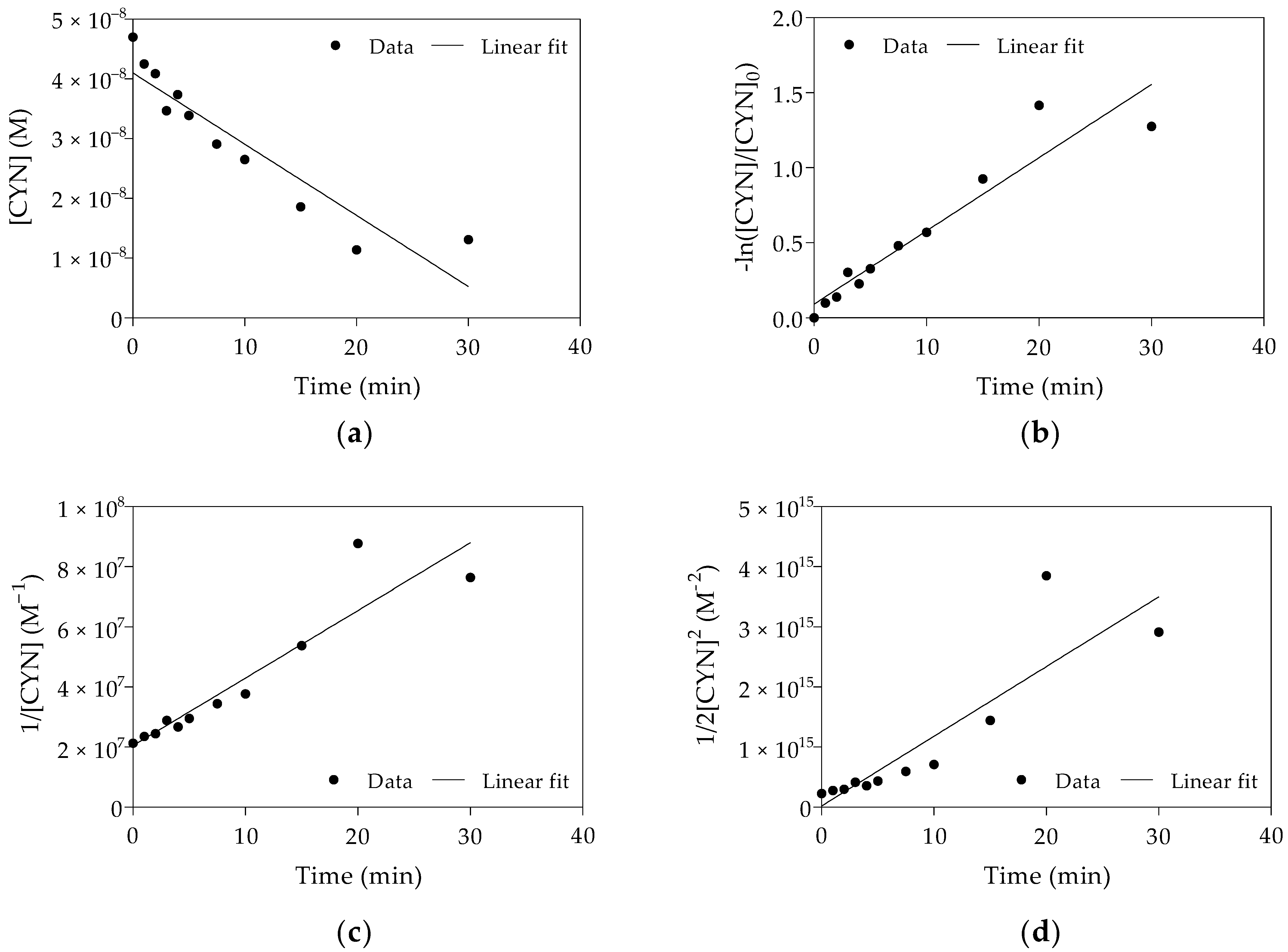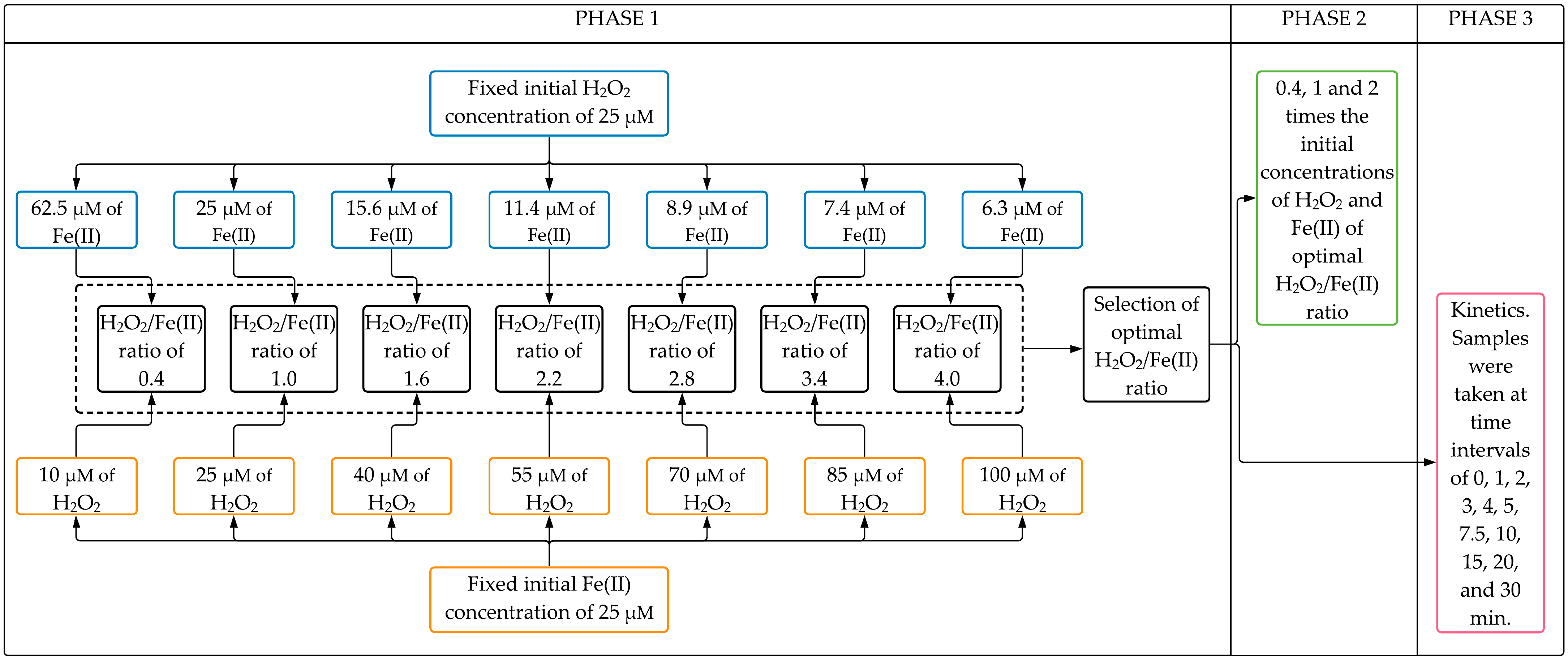Oxidation of Cylindrospermopsin by Fenton Process: A Bench-Scale Study of the Effects of Dose and Ratio of H2O2 and Fe(II) and Kinetics
Abstract
:1. Introduction
2. Results and Discussion
2.1. The Effect of H2O2/Fe(II) Molar Ration on CYN Degradation
2.2. The Effect of Initial H2O2 and Fe(II) Concentration on CYN Degradation
2.3. Kinetic Assessment
3. Summary and Conclusions
4. Materials and Methods
4.1. Chemicals
4.2. Experimental Setup
4.3. Detection and Quantification of H2O2
4.4. Detection and Quantification of Fe(II) and Total Iron
4.5. Detection and Quantification of CYN
Author Contributions
Funding
Institutional Review Board Statement
Informed Consent Statement
Acknowledgments
Conflicts of Interest
References
- Carpenter, S.R. Submersed Vegetation: An Internal Factor in Lake Ecosystem Succession. Am. Nat. 1981, 118, 372–383. [Google Scholar] [CrossRef]
- Thomas, E.A. The process of eutrophication in central European lakes. In Eutrophication: Causes, Consequences, and Correctives; National Academy of Sciences: Washington, DC, USA, 1969; pp. 29–49. [Google Scholar]
- Colby, P.J.; Spangler, G.R.; Hurley, D.A.; McCombie, A.M. Effects of Eutrophication on Salmonid Communities in Oligotrophic Lakes. J. Fish. Res. Board Can. 1972, 29, 975–983. [Google Scholar] [CrossRef]
- Nixon, S.W. Coastal marine eutrophication: A definition, social causes, and future concerns. Ophelia 1995, 41, 199–219. [Google Scholar] [CrossRef]
- Dolman, A.M.; Rücker, J.; Pick, F.; Fastner, J.; Rohrlack, T.; Mischke, U.; Wiedner, C. Cyanobacteria and Cyanotoxins: The Influence of Nitrogen versus Phosphorus. PLoS ONE 2012, 7, e38757. [Google Scholar] [CrossRef]
- Smith, V.H. Eutrophication of freshwater and coastal marine ecosystems a global problem. Environ. Sci. Pollut. Res. 2003, 10, 126–139. [Google Scholar] [CrossRef]
- Smith, V.H.; Joye, S.; Howarth, R. Eutrophication of freshwater and marine ecosystems. Limnol. Oceanogr. 2006, 51, 351–355. [Google Scholar] [CrossRef] [Green Version]
- Codd, G.A. Cyanobacterial toxins: Occurrence, properties and biological significance. Water Sci. Technol. 1995, 32, 149–156. [Google Scholar] [CrossRef]
- Carmichael, W.W. The cyanotoxins. Adv. Bot. Res. 1997, 27, 211–256. [Google Scholar]
- Antoniou, M.G.; De La Cruz, A.A.; Dionysiou, D.D. Cyanotoxins: New Generation of Water Contaminants. J. Environ. Eng. 2005, 131, 1239–1243. [Google Scholar] [CrossRef]
- Buratti, F.M.; Manganelli, M.; Vichi, S.; Stefanelli, M.; Scardala, S.; Testai, E.; Funari, E. Cyanotoxins: Producing organisms, occurrence, toxicity, mechanism of action and human health toxicological risk evaluation. Arch. Toxicol. 2017, 91, 1049–1130. [Google Scholar] [CrossRef] [PubMed]
- Humpage, A.R.; Fontaine, F.; Froscio, S.; Burcham, P.; Falconer, I. Cylindrospermopsin Genotoxicity and Cytotoxicity: Role of Cytochrome P-450 and Oxidative Stress. J. Toxicol. Environ. Health Part A 2005, 68, 739–753. [Google Scholar] [CrossRef] [PubMed]
- Falconer, I.R.; Hardy, S.J.; Humpage, A.R.; Froscio, S.M.; Tozer, G.J.; Hawkins, P.R. Hepatic and renal toxicity of the blue-green alga (cyanobacterium) Cylindrospermopsis raciborskii in male Swiss Albino mice. Environ. Toxicol. 1999, 14, 143–150. [Google Scholar] [CrossRef]
- Falconer, I.R. Cyanobacterial Toxins of Drinking Water Supplies; CRC Press: Boca Raton, FL, USA, 2004. [Google Scholar]
- Poniedziałek, B.; Rzymski, P.; Wiktorowicz, K. Experimental immunology First report of cylindrospermopsin effect on human peripheral blood lymphocytes proliferation in vitro. Cent. Eur. J. Immunol. 2012, 4, 314–317. [Google Scholar] [CrossRef] [Green Version]
- Graham, J.L.; Loftin, K.A.; Meyer, M.; Ziegler, A.C. Cyanotoxin Mixtures and Taste-and-Odor Compounds in Cyanobacterial Blooms from the Midwestern United States. Environ. Sci. Technol. 2010, 44, 7361–7368. [Google Scholar] [CrossRef] [PubMed]
- Preußel, K.; Wessel, G.; Fastner, J.; Chorus, I. Response of cylindrospermopsin production and release in Aphanizomenon flos-aquae (Cyanobacteria) to varying light and temperature conditions. Harmful Algae 2009, 8, 645–650. [Google Scholar] [CrossRef]
- US EPA. Cyanobacteria and Cyanotoxins: Information for Drinking Water Systems; US EPA: Washington, DC, USA, 2014. [Google Scholar]
- Kokociński, M.; Cameán, A.M.; Carmeli, S.; Guzmán-Guillén, R.; Jos, Á.; Mankiewicz-Boczek, J.; Metcalf, J.S.; Moreno, I.M.; Prieto, A.I.; Sukenik, A. Cylindrospermopsin and Congeners. In Handbook of Cyanobacterial Monitoring and Cyanotoxin Analysis; Meriluoto, J., Spoof, L., Codd, G.A., Eds.; John Wiley & Sons, Ltd.: Hoboken, NJ, USA, 2017; pp. 127–137. [Google Scholar]
- Chiswell, R.K.; Shaw, G.R.; Eaglesham, G.; Smith, M.J.; Norris, R.L.; Seawright, A.A.; Moore, M.R. Stability of cylindrospermopsin, the toxin from the cyanobacterium,Cylindrospermopsis raciborskii: Effect of pH, temperature, and sunlight on decomposition. Environ. Toxicol. 1999, 14, 155–161. [Google Scholar] [CrossRef]
- Keijola, A.M.; Himberg, K.; Esala, A.L.; Sivonen, K.; Hiis-Virta, L. Removal of cyanobacterial toxins in water treatment processes: Laboratory and pilot-scale experiments. Environ. Toxicol. Water Qual. 1988, 3, 643–656. [Google Scholar] [CrossRef]
- Himberg, K.; Keijola, A.-M.; Hiisvirta, L.; Pyysalo, H.; Sivonen, K. The effect of water treatment processes on the removal of hepatotoxins fromMicrocystis andOscillatoria cyanobacteria: A laboratory study. Water Res. 1989, 23, 979–984. [Google Scholar] [CrossRef]
- Teixeira, M.R.; Rosa, M.J. Comparing dissolved air flotation and conventional sedimentation to remove cyanobacterial cells of Microcystis aeruginosa: Part I: The key operating conditions. Sep. Purif. Technol. 2006, 52, 84–94. [Google Scholar] [CrossRef]
- Van Apeldoorn, M.E.; Van Egmond, H.P.; Speijers, G.J.A.; Bakker, G.J.I. Toxins of cyanobacteria. Mol. Nutr. Food Res. 2007, 51, 7–60. [Google Scholar] [CrossRef]
- Azevedo, S.M.; Carmichael, W.W.; Jochimsen, E.M.; Rinehart, K.L.; Lau, S.; Shaw, G.R.; Eaglesham, G.K. Human intoxication by microcystins during renal dialysis treatment in Caruaru—Brazil. Toxicology 2002, 181–182, 441–446. [Google Scholar] [CrossRef]
- Pouria, S.; de Andrade, A.; Barbosa, J.; Cavalcanti, R.; Barreto, V.; Ward, C.; Preiser, W.; Poon, G.K.; Neild, G.; Codd, G. Fatal microcystin intoxication in haemodialysis unit in Caruaru, Brazil. Lancet 1998, 352, 21–26. [Google Scholar] [CrossRef]
- Ministério da Saúde Brasil. Portaria no 1469, de 29 de Dezembro de 2000. Procedimentos de Controle e Vigilância da Qualidade da Água para Consumo Humano e Seu Padrão de Potabilidade; Diário Oficial da União; Federal Government of Brazil: Brasília, Brazil, 2000.
- Humpage, A.R.; Falconer, I. Oral toxicity of the cyanobacterial toxin cylindrospermopsin in male Swiss albino mice: Determination of no observed adverse effect level for deriving a drinking water guideline value. Environ. Toxicol. 2003, 18, 94–103. [Google Scholar] [CrossRef]
- Ministério da Saúde Brasil. Portaria no 2914, de 12 de Dezembro de 2011. Procedimentos de Controle e Vigilância da Qualidade da Água para Consumo Humano e Seu Padrão de Potabilidade; Diário Oficial da União; Federal Government of Brazil: Brasília, Brazil, 2011.
- Ministério da Saúde Brasil. Portaria de Consolidação GM/MS n° 888, de 4 de Maio de 2021. Procedimentos de Controle e de Vigilância da Qualidade da Água para Consumo Humano e Seu Padrão de Potabilidade; Diário Oficial da União; Federal Government of Brazil: Brasília, Brazil, 2021.
- Humpage, A.; Fastner, J. Cylindrospermopsins. In Toxic Cyanobacteria in Water; Chorus, I., Welker, M., Eds.; CRC Press: Abingdon, UK, 2021; pp. 53–71. [Google Scholar]
- Azbar, N.; Yonar, T.; Kestioglu, K. Comparison of various advanced oxidation processes and chemical treatment methods for COD and color removal from a polyester and acetate fiber dyeing effluent. Chemosphere 2004, 55, 35–43. [Google Scholar] [CrossRef]
- Cañizares, P.; Paz, R.; Saez, C.; Rodrigo, M.A. Costs of the electrochemical oxidation of wastewaters: A comparison with ozonation and Fenton oxidation processes. J. Environ. Manag. 2009, 90, 410–420. [Google Scholar] [CrossRef] [PubMed]
- Gadipelly, C.; Pérez-González, A.; Yadav, G.D.; Ortiz, I.; Ibañez, R.; Rathod, V.K.; Marathe, K. Pharmaceutical Industry Wastewater: Review of the Technologies for Water Treatment and Reuse. Ind. Eng. Chem. Res. 2014, 53, 11571–11592. [Google Scholar] [CrossRef]
- Xu, M.; Wu, C.; Zhou, Y. Advancements in the Fenton Process for Wastewater Treatment. Adv. Oxid. Process. 2020, 61. [Google Scholar] [CrossRef]
- Al Momani, F.; Smith, D.W.; El-Din, M.G. Degradation of cyanobacteria toxin by advanced oxidation processes. J. Hazard. Mater. 2008, 150, 238–249. [Google Scholar] [CrossRef] [PubMed]
- Bautista, P.; Mohedano, A.F.; Casas, J.A.; Zazo, J.A.; Rodriguez, J.J. An overview of the application of Fenton oxidation to industrial wastewaters treatment. J. Chem. Technol. Biotechnol. 2008, 83, 1323–1338. [Google Scholar] [CrossRef]
- Jiang, F.; Cao, G.; Zhuang, Y.; Wu, Z. Kinetic fluorimetry for determination of bisphenol S in plastics based on its promoting effect on the Fenton process. React. Kinet. Mech. Catal. 2020, 130, 1093–1108. [Google Scholar] [CrossRef]
- Schneider, M.; Bláha, L. Advanced oxidation processes for the removal of cyanobacterial toxins from drinking water. Environ. Sci. Eur. 2020, 32, 1–24. [Google Scholar] [CrossRef]
- De Laat, J.; Gallard, H. Catalytic Decomposition of Hydrogen Peroxide by Fe(III) in Homogeneous Aqueous Solution: Mechanism and Kinetic Modeling. Environ. Sci. Technol. 1999, 33, 2726–2732. [Google Scholar] [CrossRef]
- Bielski, B.H.J.; Cabelli, D.E.; Arudi, R.L.; Ross, A.B. Reactivity of HO2/O−2 Radicals in Aqueous Solution. J. Phys. Chem. Ref. Data 1985, 14, 1041–1100. [Google Scholar] [CrossRef]
- Tang, W.Z.; Huang, C.P. 2,4-Dichlorophenol oxidation kinetics by Fenton’s reagent. Environ. Technol. 1996, 17, 1371–1378. [Google Scholar] [CrossRef]
- Rigg, T.; Taylor, W.; Weiss, J. The Rate Constant of the Reaction between Hydrogen Peroxide and Ferrous Ions. J. Chem. Phys. 1954, 22, 575–577. [Google Scholar] [CrossRef]
- Walling, C.; Goosen, A. Mechanism of the ferric ion catalyzed decomposition of hydrogen peroxide. Effect of organic substrates. J. Am. Chem. Soc. 1973, 95, 2987–2991. [Google Scholar] [CrossRef]
- Buxton, G.V.; Greenstock, C.L.; Helman, W.P.; Ross, A.B. Critical Review of rate constants for reactions of hydrated electrons, hydrogen atoms and hydroxyl radicals (OH/O−) in Aqueous Solution. J. Phys. Chem. Ref. Data 1988, 17, 513–886. [Google Scholar] [CrossRef] [Green Version]
- Rush, J.D.; Bielski, B.H.J. Pulse radiolysis studies of alkaline iron(III) and iron(VI) solutions. Observation of transient iron complexes with intermediate oxidation states. J. Am. Chem. Soc. 1986, 108, 523–525. [Google Scholar] [CrossRef]
- Roudi, A.M.; Chelliapan, S.; Mohtar, W.H.M.W.; Kamyab, H. Prediction and Optimization of the Fenton Process for the Treatment of Landfill Leachate Using an Artificial Neural Network. Water 2018, 10, 595. [Google Scholar] [CrossRef] [Green Version]
- Miller, C.J.; Wadley, S.; Waite, T.D. Fenton, photo-Fenton and Fenton-like processes. In Advanced Oxidation Processes for Water Treatment: Fundamentals and Applications; Stefan, M.I., Ed.; IWA Publishing: London, UK, 2017; pp. 297–332. [Google Scholar]
- Vasquez-Medrano, R.; Prato-Garcia, D.; Vedrenne, M. Ferrioxalate-mediated processes. In Advanced Oxidation Processes for Waste Water Treatment: Emerging Green Chemical Technology; Ameta, S.C., Ameta, R., Eds.; Academic Press: Cambridge, MA, USA, 2018; pp. 89–113. [Google Scholar]
- Babuponnusami, A.; Muthukumar, K. Degradation of Phenol in Aqueous Solution by Fenton, Sono-Fenton and Sono-photo-Fenton Methods. CLEAN Soil Air Water 2011, 39, 142–147. [Google Scholar] [CrossRef]
- Kavitha, V.; Palanivelu, K. The role of ferrous ion in Fenton and photo-Fenton processes for the degradation of phenol. Chemosphere 2004, 55, 1235–1243. [Google Scholar] [CrossRef] [PubMed]
- Vione, D.; Merlo, F.; Maurino, V.; Minero, C. Effect of humic acids on the Fenton degradation of phenol. Environ. Chem. Lett. 2004, 2, 129–133. [Google Scholar] [CrossRef]
- Ioan, I.; Wilson, S.R.; Lundanes, E.; Neculai, A. Comparison of Fenton and sono-Fenton bisphenol A degradation. J. Hazard. Mater. 2007, 142, 559–563. [Google Scholar] [CrossRef] [PubMed]
- Chen, W.; Zou, C.; Liu, Y.; Li, X. The experimental investigation of bisphenol A degradation by Fenton process with different types of cyclodextrins. J. Ind. Eng. Chem. 2017, 56, 428–434. [Google Scholar] [CrossRef]
- Cravotto, G.; Di Carlo, S.; Tumiatti, V.; Roggero, C.; Bremner, H.D. Degradation of Persistent Organic Pollutants by Fenton’s Reagent Facilitated by Microwave or High-intensity Ultrasound. Environ. Technol. 2005, 26, 721–724. [Google Scholar] [CrossRef] [PubMed]
- Göde, J.N.; Souza, D.H.; Trevisan, V.; Skoronski, E. Application of the Fenton and Fenton-like processes in the landfill leachate tertiary treatment. J. Environ. Chem. Eng. 2019, 7, 103352. [Google Scholar] [CrossRef]
- Zhang, H.; Choi, H.J.; Huang, C.-P. Optimization of Fenton process for the treatment of landfill leachate. J. Hazard. Mater. 2005, 125, 166–174. [Google Scholar] [CrossRef]
- Hermosilla, D.; Cortijo, M.; Huang, C.P. Optimizing the treatment of landfill leachate by conventional Fenton and photo-Fenton processes. Sci. Total. Environ. 2009, 407, 3473–3481. [Google Scholar] [CrossRef] [PubMed]
- Park, J.-A.; Yang, B.; Park, C.; Choi, J.-W.; van Genuchten, C.; Lee, S.-H. Oxidation of microcystin-LR by the Fenton process: Kinetics, degradation intermediates, water quality and toxicity assessment. Chem. Eng. J. 2017, 309, 339–348. [Google Scholar] [CrossRef]
- Bandala, E.R.; Martínez, D.; Martínez, E.; Dionysiou, D.D. Degradation of microcystin-LR toxin by Fenton and Photo-Fenton processes. Toxicon 2004, 43, 829–832. [Google Scholar] [CrossRef]
- Zhong, Y.; Jin, X.; Qiao, R.; Qi, X.; Zhuang, Y. Destruction of microcystin-RR by Fenton oxidation. J. Hazard. Mater. 2009, 167, 1114–1118. [Google Scholar] [CrossRef]
- Gajdek, P.; Lechowski, Z.; Bochnia, T.; Kępczyński, M. Decomposition of microcystin-LR by Fenton oxidation. Toxicon 2001, 39, 1575–1578. [Google Scholar] [CrossRef]
- Bober, B.; Pudas, K.; Lechowski, Z.; Bialczyk, J. Degradation of microcystin-LR by ozone in the presence of Fenton reagent. J. Environ. Sci. Health Part A 2008, 43, 186–190. [Google Scholar] [CrossRef]
- Munoz, M.; Nieto-Sandoval, J.; Cirés, S.; de Pedro, Z.M.; Quesada, A.; Casas, J.A. Degradation of widespread cyanotoxins with high impact in drinking water (microcystins, cylindrospermopsin, anatoxin-a and saxitoxin) by CWPO. Water Res. 2019, 163, 114853. [Google Scholar] [CrossRef]
- Henz, S.K.F.; De sousa, D.S.; Ginoris, Y.P.; Brandão, C.C.S. Remoção de cilindrospermopsinas por meio do processo Fenton no tratamento de água. In Anais do XXIII Simpósio Brasileiro de Recursos Hídricos; ABRHidro: Foz do Iguaçu, Brasil, 2019; pp. 1–10. [Google Scholar]
- Banker, R.; Carmeli, S.; Werman, M.; Teltsch, B.; Porat, R.; Sukenik, A. Uracil Moiety is Required for Toxicity of the Cyanobacterial Hepatotoxin Cylindrospermopsin. J. Toxicol. Environ. Health Part A 2001, 62, 281–288. [Google Scholar] [CrossRef] [PubMed]
- Chen, L.; Zhao, C.; Dionysiou, D.D.; O’Shea, K.E. TiO2 photocatalytic degradation and detoxification of cylindrospermopsin. J. Photochem. Photobiol. A Chem. 2015, 307–308, 115–122. [Google Scholar] [CrossRef]
- Zhang, G.; Wurtzler, E.; He, X.; Nadagouda, M.; O’Shea, K.; El-Sheikh, S.M.; Ismail, A.A.; Wendell, D.; Dionysiou, D. Identification of TiO2 photocatalytic destruction byproducts and reaction pathway of cylindrospermopsin. Appl. Catal. B Environ. 2015, 163, 591–598. [Google Scholar] [CrossRef]
- Hurowitz, J.A.; Tosca, N.J.; Dyar, M.D. Acid production by FeSO4·nH2O dissolution and implications for terrestrial and martian aquatic systems. Am. Mineral. 2009, 94, 409–414. [Google Scholar] [CrossRef]
- Tekin, H.; Bilkay, O.; Ataberk, S.S.; Balta, T.H.; Ceribasi, I.H.; Sanin, F.D.; Dilek, F.B.; Yetis, U. Use of Fenton oxidation to improve the biodegradability of a pharmaceutical wastewater. J. Hazard. Mater. 2006, 136, 258–265. [Google Scholar] [CrossRef] [PubMed]
- Pignatello, J.J.; Oliveros, E.; Mackay, A. Advanced Oxidation Processes for Organic Contaminant Destruction Based on the Fenton Reaction and Related Chemistry. Crit. Rev. Environ. Sci. Technol. 2006, 36, 1–84. [Google Scholar] [CrossRef]
- Lawton, L.; Robertson, P. Physico-chemical treatment methods for the removal of microcystins (cyanobacterial hepatotoxins) from potable waters. Chem. Soc. Rev. 1999, 28, 217–224. [Google Scholar] [CrossRef]
- Lee, H.; Lee, H.J.; Sedlak, D.L.; Lee, C. pH-Dependent reactivity of oxidants formed by iron and copper-catalyzed decomposition of hydrogen peroxide. Chemosphere 2013, 92, 652–658. [Google Scholar] [CrossRef] [PubMed]
- Álvarez-Torrellas, S.; Munoz, M.; Mondejar, V.; De Pedro, Z.M.; Casas, J.A. Boosting the catalytic activity of natural magnetite for wet peroxide oxidation. Environ. Sci. Pollut. Res. 2018, 27, 1176–1185. [Google Scholar] [CrossRef] [PubMed]
- Garrido-Ramírez, E.; Theng, B.; Mora, M.L. Clays and oxide minerals as catalysts and nanocatalysts in Fenton-like reactions—A review. Appl. Clay Sci. 2010, 47, 182–192. [Google Scholar] [CrossRef]
- Liu, W.; Andrews, S.A.; Stefan, M.I.; Bolton, J.R. Optimal methods for quenching H2O2 residuals prior to UFC testing. Water Res. 2003, 37, 3697–3703. [Google Scholar] [CrossRef]
- Bader, H.; Sturzenegger, V.; Hoigné, J. Photometric method for the determination of low concentrations of hydrogen peroxide by the peroxidase catalyzed oxidation of N,N-diethyl-p-phenylenediamine (DPD). Water Res. 1988, 22, 1109–1115. [Google Scholar] [CrossRef]
- Magnusson, B. Örnemark, U. Eurachem Guide: The Fitness for Purpose of Analytical Methods—A Laboratory Guide to Method Validation and Related Topics, 2nd ed.; LGC: London, UK, 2014. [Google Scholar]
- Viollier, E.; Inglett, P.; Hunter, K.; Roychoudhury, A.; Van Cappellen, P. The ferrozine method revisited: Fe(II)/Fe(III) determination in natural waters. Appl. Geochem. 2000, 15, 785–790. [Google Scholar] [CrossRef]





| Kinetic Model | Replicate 1 | Replicate 2 b | Replicate 3 | Average | ||||||||
|---|---|---|---|---|---|---|---|---|---|---|---|---|
| k a | T1/2 (min) | R2 | k a | T1/2 (min) | R2 | k a | T1/2 (min) | R2 | k a | T1/2 (min) | R2 | |
| Zero | 1.925 × 10−11 | 19.1 | 0.76 | 1.987 × 10−11 | 19.7 | 0.87 | 3.799 × 10−11 | 11.9 | 0.90 | 2.570 × 10−11 | 16.9 | 0.84 |
| First | 1.007 × 10−3 | 11.5 | 0.80 | 0.813 × 10−3 | 14.2 | 0.90 | 1.879 × 10−3 | 6.1 | 0.98 | 1.233 × 10−3 | 10.6 | 0.89 |
| Second | 6.435 × 104 | 5.9 | 0.73 | 3.748 × 104 | 9.5 | 0.87 | 13.390 × 104 | 2.3 | 0.87 | 7.858 × 104 | 5.9 | 0.82 |
| Third | 4.978 × 1012 | 2.6 | 0.60 | 1.934 × 1012 | 5.9 | 0.79 | 13.460 × 1012 | 0.6 | 0.72 | 9.219 × 1012 | 3.0 | 0.70 |
Publisher’s Note: MDPI stays neutral with regard to jurisdictional claims in published maps and institutional affiliations. |
© 2021 by the authors. Licensee MDPI, Basel, Switzerland. This article is an open access article distributed under the terms and conditions of the Creative Commons Attribution (CC BY) license (https://creativecommons.org/licenses/by/4.0/).
Share and Cite
Ferreira, M.A.; Brandão, C.C.S.; Ginoris, Y.P. Oxidation of Cylindrospermopsin by Fenton Process: A Bench-Scale Study of the Effects of Dose and Ratio of H2O2 and Fe(II) and Kinetics. Toxins 2021, 13, 604. https://doi.org/10.3390/toxins13090604
Ferreira MA, Brandão CCS, Ginoris YP. Oxidation of Cylindrospermopsin by Fenton Process: A Bench-Scale Study of the Effects of Dose and Ratio of H2O2 and Fe(II) and Kinetics. Toxins. 2021; 13(9):604. https://doi.org/10.3390/toxins13090604
Chicago/Turabian StyleFerreira, Matheus Almeida, Cristina Celia Silveira Brandão, and Yovanka Pérez Ginoris. 2021. "Oxidation of Cylindrospermopsin by Fenton Process: A Bench-Scale Study of the Effects of Dose and Ratio of H2O2 and Fe(II) and Kinetics" Toxins 13, no. 9: 604. https://doi.org/10.3390/toxins13090604
APA StyleFerreira, M. A., Brandão, C. C. S., & Ginoris, Y. P. (2021). Oxidation of Cylindrospermopsin by Fenton Process: A Bench-Scale Study of the Effects of Dose and Ratio of H2O2 and Fe(II) and Kinetics. Toxins, 13(9), 604. https://doi.org/10.3390/toxins13090604





